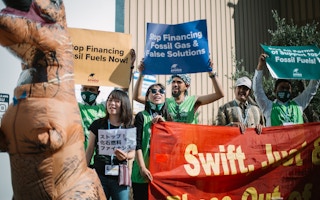Every year, in a well-choreographed succession of international summits, climate negotiators spend valuable political capital wrangling about the billions and trillions needed globally to finance the energy transition.
The international community met again two weeks ago, this time in Paris, to seek the reform of the multilateral financial system to address climate change. But even if all these summits may result in statements about the “allocation” of billions of new climate finance commitments – which are always welcome – this discussion may distract from a more pressing need: project financing.
Financing projects is boring. It does not produce attention-grabbing headlines, nor does it go viral on social media. Yet, if we are to tackle climate change, understanding and addressing the factors that make project financing possible is critical, as we show in our recent report. It is time for the international community to pay serious attention and spend political capital on the mechanisms through which finance translates into actual projects, particularly in developing economies.
Most climate investments are expected to be mobilised from private (i.e. profit seeking) sources. But private finance flows only into projects that can prove viability, i.e. an adequate risk-adjusted return.
Let us take for example wind power and solar photovoltaics (PV), both successful technologies particularly suitable for private investment, currently being deployed at a fast pace in many regions of the world. The process of developing each solar and wind plant is complex, iterative and time-consuming. It involves numerous actors: developers, lenders, contractors, utilities, regulators, and service providers, with a web of contracts and liabilities between them.
“
The role of private financiers is to identify projects that earn an adequate risk-adjusted return and to stay away from the ones that do not. Private financiers will not change their methods any time soon. The realistic role of policy, then, is not to attempt to change their criteria, but to help countries and projects meet those criteria.
This complexity stems from distributing risks and responsibilities among parties in a way that convinces lenders that the project will promptly service its long-term debt. Thus, when the projected revenues, costs, and perceived risks meet the criteria of investors, finance flows and the project is built. The whole process takes a few years from inception to operation, even when everything goes smoothly.
The number of such projects required to meet climate goals is staggering. The IEA estimates that Africa as a whole would need the addition of nearly 130GW of installed capacity for solar PV until 2030 to meet its Sustainable Africa Scenario. At current average project size, this amounts to more than one new solar PV project becoming operational every single day from now until 2030.
Would “allocating” more finance help in the short term? Unlikely. Climate finance still needs thousands of viable projects to flow into. There is a clear shortage of such opportunities, particularly in developing countries. While there have been recent proposals for a centralised AI-driven approach to create a pipeline of projects, the core of the problem is not a lack of projects, but ensuring their viability.
The role of private financiers is to identify projects that earn an adequate risk-adjusted return and to stay away from the ones that do not. Much of their skill consists in distinguishing between the two. As a Mozambique commercial banker put it: “my job is to avoid failing projects, even if someone else [such as a Development Finance Institution (DFI)] picks up the bill.”
Private financiers will not change their methods any time soon. The realistic role of policy, then, is not to attempt to change their criteria, but to help countries and projects meet those criteria. Achieving this may require short-term interventions such as technical assistance or risk mitigation, as well as long-term policies on improving the business environment. Such interventions can both enable more successful projects and make them more affordable, by reducing the cost of capital.
Our research shows that, with adequate risk mitigation, private investment is possible in countries like Mozambique or Malawi, both least developed countries (LDCs) with no prior experience with solar PV. Recent DFI-led risk mitigation programs like Scaling Solar in Zambia and GETFiT in Uganda have seen sizable projects financed and built. But even those programs struggle with pace and replicability. To accelerate private investment, even more effort needs to go into identifying and addressing the barriers that deter the viability of projects. Specifically, we need to increase many-fold the effort devoted to risk mitigation programs as a realistic way of harnessing the capabilities of the private sector.
The critical role of project viability comes as no surprise to investors and developers, but this knowledge, somehow, seems lost in translation (or not to be a priority) to international delegates negotiating about billions and trillions of climate finance. Yet we may not be able to deploy even a fraction of that if conditions in developing countries hinder project viability. Effort would be better spent understanding why projects in developing countries struggle to reach viability, and creating the environment that enables such investment opportunities. It’s only then that private finance will flow, and the projects will become reality.
This story was published with permission from Thomson Reuters Foundation, the charitable arm of Thomson Reuters, that covers humanitarian news, climate change, resilience, women’s rights, trafficking and property rights. Visit https://www.context.news/.












